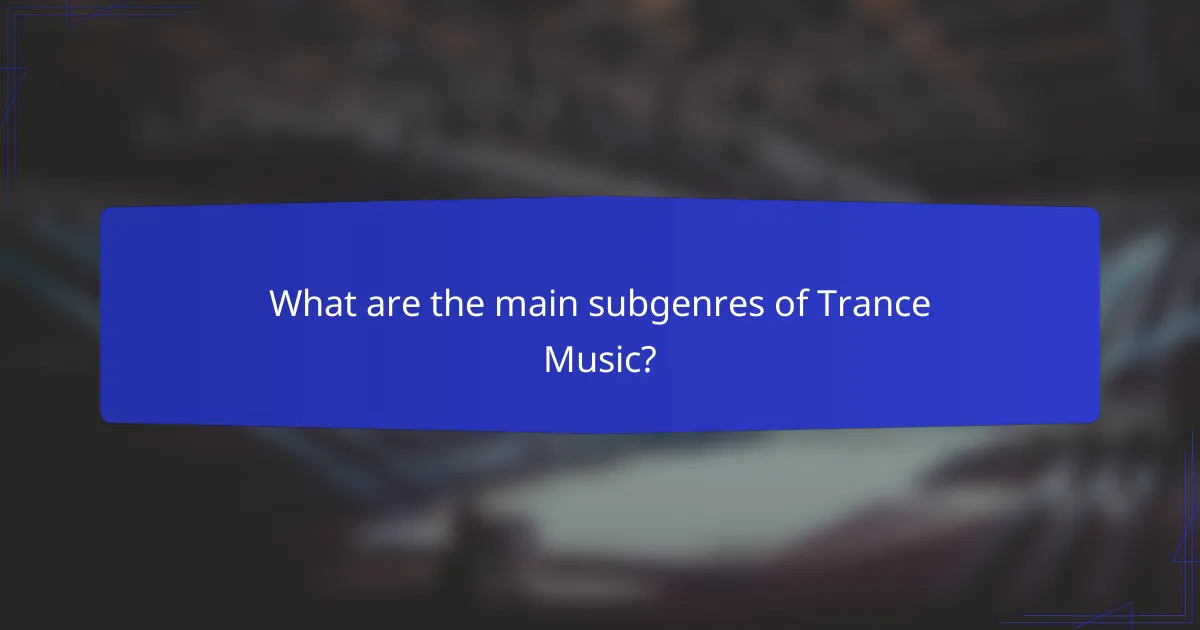Trance music is a genre of electronic dance music characterized by melodic and repetitive structures, typically featuring a tempo ranging from 125 to 150 beats per minute. Emerging in the early 1990s, it draws influences from house, techno, and ambient music, and is known for its emotional build-ups and breakdowns. Key elements include synthesizers, drum machines, and vocal samples, with popular subgenres such as progressive trance, uplifting trance, psytrance, and tech trance, each appealing to different audiences. Iconic tracks like Tiësto’s “Adagio for Strings,” Darude’s “Sandstorm,” and Robert Miles’ “Children” have significantly shaped the trance music landscape, showcasing its impact on the electronic music scene.

What is Trance Music?
Trance music is a genre of electronic dance music known for its melodic and repetitive structure. It typically features a tempo of 125 to 150 beats per minute. The genre emerged in the early 1990s, influenced by house, techno, and ambient music. Trance is characterized by build-ups and breakdowns, creating emotional and euphoric experiences.
Key elements include synthesizers, drum machines, and vocal samples. Popular subgenres include progressive trance, uplifting trance, and psytrance. Trance music is often played at festivals and clubs, attracting large audiences. Iconic tracks like “Adagio for Strings” by Tiësto exemplify its impact on the electronic music scene.
How did Trance Music originate?
Trance music originated in the late 1980s and early 1990s. It emerged from the electronic dance music scene in Germany. Influences included house, techno, and ambient music. The genre is characterized by melodic phrases and a tempo ranging from 125 to 150 BPM. Early pioneers included artists like Paul van Dyk and Sven Väth. Trance gained popularity through raves and music festivals. By the mid-1990s, it had a global following. The genre evolved into various subgenres, including progressive trance and uplifting trance.
What cultural influences shaped the development of Trance Music?
Trance music was shaped by various cultural influences, including electronic dance music, psychedelic culture, and global musical traditions. The emergence of electronic dance music in the late 1980s laid the groundwork for trance. Influences from genres like house and techno contributed to its rhythmic structure. Psychedelic culture of the 1960s and 1970s introduced elements of [censured] and transcendence. This led to the incorporation of ethereal sounds and uplifting melodies in trance. Additionally, global musical traditions, such as Indian classical music, influenced trance’s melodic and harmonic structures. The fusion of these cultural elements created the distinct sound of trance music.
Who are the key figures in the history of Trance Music?
Key figures in the history of Trance Music include artists like Paul van Dyk, Armin van Buuren, and Tiësto. Paul van Dyk is known for his influential tracks and pioneering work in the genre since the 1990s. Armin van Buuren has been a prominent figure with multiple Grammy nominations and a long-running radio show, “A State of Trance.” Tiësto gained fame for his energetic performances and was the first DJ to play live at the Olympics in 2004. Other notable figures include Ferry Corsten, Sasha, and Above & Beyond, who have all contributed significantly to the genre’s evolution and popularity.
What are the defining characteristics of Trance Music?
Trance music is characterized by its melodic and repetitive structure. It typically features a tempo ranging from 125 to 150 BPM. The use of build-ups and breakdowns creates emotional peaks in the music. Synthesizers and electronic instruments are prominent in trance production. Vocals may be present but are often minimal and ethereal. The genre aims to induce a state of trance or euphoria in listeners. Subgenres include progressive trance and uplifting trance, each with distinct attributes. Trance music has a strong presence in dance clubs and music festivals globally.
How does tempo and rhythm influence the Trance experience?
Tempo and rhythm significantly influence the Trance experience by shaping emotional responses and enhancing immersion. Trance music typically features a tempo ranging from 125 to 150 beats per minute. This specific tempo creates a driving force that encourages movement and connection among listeners. The repetitive rhythm fosters a hypnotic state, allowing individuals to lose themselves in the music. Studies show that consistent beats can elicit positive emotional responses, reinforcing feelings of euphoria. Additionally, variations in rhythm can build tension and release, contributing to climactic moments in tracks. This dynamic interplay of tempo and rhythm is essential for creating the desired Trance experience.
What role do melodies and harmonies play in Trance tracks?
Melodies and harmonies are crucial elements in Trance tracks. They create emotional depth and enhance the overall listening experience. Melodies often serve as the main theme, driving the track forward. Harmonies complement melodies, adding richness and complexity. Together, they evoke feelings of euphoria and introspection. The repetitive nature of these elements helps establish a trance-like state. This state is essential for engaging listeners during live performances. Studies indicate that melodic progression in Trance can influence mood and energy levels significantly.
What emotional impact does Trance Music have on listeners?
Trance music evokes strong emotional responses in listeners. It often induces feelings of euphoria and connection. The repetitive beats and melodic progressions create an immersive experience. This genre can lead to a sense of transcendence during live performances. Research indicates that trance music can elevate mood and reduce anxiety. The emotional impact is often linked to its structure and rhythm. Listeners report heightened states of happiness and relaxation. Studies show that music can trigger the release of dopamine, enhancing pleasure.
How does Trance Music evoke specific emotions?
Trance music evokes specific emotions through its melodic structures and rhythmic patterns. The genre often features uplifting melodies that create feelings of euphoria and transcendence. Its repetitive beats and build-ups contribute to a sense of anticipation and release. This emotional journey is enhanced by the use of atmospheric sounds and harmonies. Research indicates that music can trigger emotional responses due to its ability to activate brain regions associated with pleasure. Studies show that listeners often report feelings of happiness and connection while experiencing trance music. The combination of these elements makes trance music particularly effective in influencing emotions.
What psychological effects are associated with listening to Trance Music?
Listening to trance music can induce various psychological effects. It often promotes relaxation and reduces stress levels. Many listeners report feelings of euphoria and heightened emotional states. The repetitive beats and melodies can lead to a trance-like state of consciousness. This state can enhance creativity and facilitate introspection. Research has shown that trance music can improve mood and increase feelings of happiness. Additionally, it may aid in developing a sense of connection with others during social gatherings. Overall, the psychological effects of trance music are generally positive and can enhance the listening experience.

What are the main subgenres of Trance Music?
The main subgenres of Trance Music include Progressive Trance, Uplifting Trance, Psytrance, and Tech Trance. Progressive Trance features gradual build-ups and melodic elements. Uplifting Trance is known for its euphoric melodies and emotional climaxes. Psytrance incorporates psychedelic elements and faster tempos. Tech Trance combines techno influences with trance’s melodic aspects. Each subgenre has distinct characteristics that appeal to different audiences within the trance music community.
How do the subgenres of Trance Music differ from one another?
Subgenres of Trance Music differ primarily in tempo, structure, and emotional emphasis. For example, Progressive Trance features a slower tempo and focuses on building atmosphere. In contrast, Uplifting Trance is characterized by faster beats and euphoric melodies. Tech Trance incorporates elements of techno, resulting in a harder sound. Psychedelic Trance emphasizes unique soundscapes and intricate rhythms, often with a faster tempo. Each subgenre targets distinct emotional responses, from introspective to euphoric. This diversity allows for a wide range of experiences within the Trance Music genre.
What are the characteristics of Progressive Trance?
Progressive Trance is characterized by its gradual build-up and layered melodies. The tempo typically ranges from 128 to 135 BPM. It features long, evolving tracks that focus on atmosphere and emotion. Synthesizers are commonly used to create lush soundscapes. The basslines are deep and driving, providing a solid foundation. Vocals may be minimal or ethereal, enhancing the overall mood. Progressive Trance often incorporates elements from house music, adding to its rhythmic complexity. The genre emphasizes a journey-like experience, engaging listeners over extended periods.
What makes Uplifting Trance unique?
Uplifting Trance is unique due to its emotional resonance and melodic structure. This subgenre emphasizes euphoric melodies and uplifting chord progressions. Tracks often feature long build-ups leading to climactic drops. The use of arpeggios and vocal samples enhances the emotional connection. Uplifting Trance typically has a tempo ranging from 130 to 140 BPM. Its focus on positivity sets it apart from darker trance subgenres. Iconic artists like Armin van Buuren and Above & Beyond define this style. The genre aims to evoke feelings of joy and transcendence during live performances.
What are some notable subgenres in Trance Music?
Notable subgenres in trance music include Progressive Trance, Uplifting Trance, and Psytrance. Progressive Trance is characterized by its gradual build-ups and melodic progressions. Uplifting Trance features euphoric melodies and emotional breakdowns. Psytrance, originating from the psychedelic scene, incorporates complex rhythms and synthesized sounds. Each subgenre has its unique attributes and appeals to different audiences. For instance, Uplifting Trance often aims to evoke strong emotional responses. In contrast, Psytrance focuses on creating an immersive auditory experience. These distinctions highlight the diversity within trance music.
How does Psychedelic Trance stand out?
Psychedelic Trance stands out through its unique sound and cultural influence. This subgenre features intricate melodies, fast tempos, and deep basslines. The typical BPM ranges from 130 to 150, creating an energetic atmosphere. It often incorporates elements of surrealism and fantasy in its themes. Psychedelic Trance is known for its immersive experience, often enhancing emotional states during live performances. The genre has roots in the Goa Trance scene of the late 1980s and early 1990s. Artists like Infected Mushroom and Astrix have significantly shaped its evolution. The use of complex soundscapes distinguishes it from other trance subgenres.
What defines Tech Trance and its appeal?
Tech Trance is a subgenre of trance music characterized by its driving basslines and intricate melodies. It combines elements of techno and trance, creating a rhythmic and energetic sound. The appeal of Tech Trance lies in its ability to evoke deep emotional responses while maintaining a danceable beat. It often features progressive builds and drops, which create a sense of anticipation and release for listeners. The genre’s unique sound design and production techniques attract both DJs and electronic music enthusiasts. Events and festivals dedicated to trance music often showcase Tech Trance, further enhancing its popularity.
![]()
What are some iconic tracks in Trance Music?
Some iconic tracks in Trance Music include “Adagio for Strings” by Tiësto, “Sandstorm” by Darude, and “Children” by Robert Miles. “Adagio for Strings” is a remix of Samuel Barber’s classical piece. It became a staple in the trance scene after its release in 2005. “Sandstorm” was released in 1999 and is known for its energetic beats. It remains a popular anthem at festivals. “Children,” released in 1995, features a memorable piano melody. This track helped define the genre’s sound in the 1990s. Each of these tracks has significantly influenced the evolution of trance music.
Which tracks are considered classics in the Trance genre?
Classics in the Trance genre include “Adagio for Strings” by Tiësto and “Children” by Robert Miles. “Adagio for Strings” was released in 2005 and is known for its emotional buildup. “Children” was released in 1996 and features a memorable melody. Another iconic track is “Sandstorm” by Darude, which became a global hit in 1999. “For An Angel” by Paul van Dyk is also considered a classic, released in 1998. These tracks are often played in festivals and clubs, showcasing their lasting impact on the genre.
What impact did “Adagio for Strings” have on the Trance scene?
“Adagio for Strings” significantly influenced the Trance scene by popularizing orchestral elements within electronic music. Its emotional depth resonated with listeners, setting a precedent for melodic compositions in Trance. The track, originally composed by Samuel Barber, was remixed by Tiësto in 2005, which brought it into mainstream dance music. This remix became an anthem at festivals, showcasing how classical music can blend with electronic genres. The use of sweeping strings and powerful build-ups in the remix exemplified the emotional highs characteristic of Trance. The success of “Adagio for Strings” inspired many producers to incorporate similar orchestral arrangements in their tracks. Its impact can be seen in the evolution of Trance, where emotional resonance became a key element. The track remains a staple in DJ sets, illustrating its lasting influence on the genre.
How did “Children” by Robert Miles shape the genre’s popularity?
“Children” by Robert Miles significantly shaped the popularity of trance music. Released in 1995, it became a defining track of the genre. The song’s emotive melodies and soothing piano lines resonated with a broad audience. It reached number one in multiple countries, including the UK and Germany. Its success brought mainstream attention to trance music. The track also played a crucial role in establishing the genre in clubs and radio stations. Its unique blend of emotional depth and danceability set a standard for future trance tracks. Overall, “Children” helped to elevate trance music from underground scenes to global recognition.
What contemporary tracks are shaping the future of Trance Music?
Contemporary tracks shaping the future of Trance Music include “Resurrection” by Paul van Dyk and “The Last Goodbye” by Gareth Emery. These tracks incorporate innovative production techniques and emotional storytelling. “Resurrection” features a blend of classic Trance elements with modern sound design. It has received critical acclaim and significant airplay. “The Last Goodbye” showcases a collaboration with a popular vocalist, enhancing its appeal. Both tracks reflect the evolving landscape of Trance Music. They set trends for upcoming artists and influence new releases. This impact is evident in the growing popularity of melodic and uplifting Trance subgenres.
Which artists are currently leading the Trance movement?
Armin van Buuren, Above & Beyond, and Paul van Dyk are currently leading the Trance movement. Armin van Buuren has been a prominent figure in Trance for over two decades. He has won multiple DJ Mag Top 100 DJs awards. Above & Beyond is known for their emotional tracks and live performances. They also host the popular Group Therapy radio show. Paul van Dyk is a pioneer in the genre, with a career spanning more than 20 years. His influence on Trance music is significant. These artists consistently release new music and perform at major festivals. Their contributions keep the Trance movement vibrant and evolving.
What elements in modern Trance tracks resonate with audiences today?
Modern Trance tracks resonate with audiences today through emotional melodies, uplifting build-ups, and driving basslines. Emotional melodies create a deep connection with listeners, often evoking feelings of nostalgia or euphoria. Uplifting build-ups enhance anticipation, leading to satisfying drops that energize the crowd. Driving basslines provide a rhythmic foundation, making tracks danceable and engaging. Atmospheric pads and arpeggios add layers of depth, enriching the overall sound. Vocals, when included, often convey relatable themes, further enhancing emotional impact. The combination of these elements creates an immersive experience that captivates audiences in live settings and personal listening.
How can listeners enhance their experience with Trance Music?
Listeners can enhance their experience with Trance Music by immersing themselves in the genre’s unique atmosphere. Engaging in active listening can deepen emotional connections to the music. Attending live events amplifies the experience through communal energy and visual effects. Creating a dedicated listening space can improve focus and enjoyment. Using high-quality headphones or speakers enhances sound clarity and detail. Exploring different subgenres of Trance can introduce variety and broaden appreciation. Participating in online forums or communities allows for sharing insights and recommendations. Regularly updating playlists keeps the experience fresh and exciting.
Trance Music is an electronic dance genre characterized by its melodic and repetitive structure, typically featuring a tempo of 125 to 150 beats per minute. The article explores the origins of trance music, its cultural influences, and key figures who shaped its development, such as Paul van Dyk and Armin van Buuren. It also examines the defining characteristics of trance, including emotional impact, the role of melodies and rhythms, and the various subgenres like Progressive Trance and Psytrance. Additionally, iconic tracks and contemporary influences are highlighted, showcasing the genre’s evolution and ongoing relevance in the music scene.

